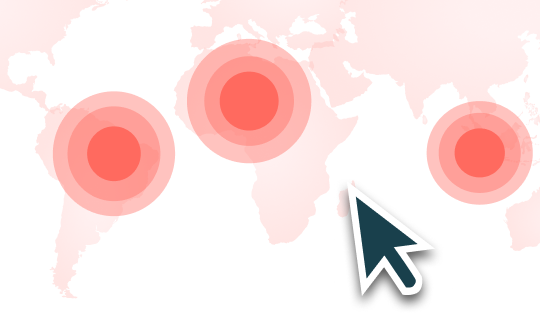Bolivia is the world’s tenth largest soy producer and exporter, accounting for 0.9% of global production. In 2021, it produced about 3.3 million tonnes of soy, of which 2.5 million tonnes were exported mainly to Colombia and Peru; 77% as soybean cake, 20% soybean oil and 3% raw soybeans. In 2021, soy was Bolivia’s fourth largest export, accounting for 12% of total exports and generating an annual revenue of about US$1.3 billion.
Trase data shows that soy production in 2020 was linked to 77,090 ha of deforestation and conversion of native ecosystems, increasing to 105,600 ha in 2021. The total area of soy planted also increased from 778,600 ha in 2020 to 1.088 million ha (Mha) in 2021.
This suggests that soy is increasingly a direct driver of deforestation and conversion of forests and other types of native vegetation. This expansion is due to growing exports, especially to Colombia and Peru, as well as for domestic use. According to Mapbiomas Bolivia, of the 7.2 Mha of agricultural land in 2020, of which 778,600 ha were soy plantations, almost 19% (1.3 Mha) were forests and other types of native vegetation in 2015.
Trase data shows that in 2021, 31.8 hectares of native vegetation were deforested for every thousand tonnes of soy produced in Bolivia. This level of soy deforestation intensity is seven times higher than in Brazil (4.6 hectares per kilotonne in 2020), more than thirty times higher than Argentina (0.93 ha/kt in 2019) and over five times higher than Paraguay – another active soy deforestation frontier (5.9 ha/kt).
Most soy-producing regions are tainted by soy deforestation and conversion
The municipalities in Bolivia with the most soy deforestation and conversion in 2021 are San Jose de Chiquitos (35,158 ha), Pailon (26,016 ha), San Ignacio de Velasco (16,426 ha), Cuatro Canãdas (14,203 ha), San Julian (5,923 ha), El Puente (2,949 ha) and San Miguel de Velasco (1,507 ha).
In 2021, these seven municipalities accounted for 95% of soy deforestation and conversion in Bolivia and represented about 80% of the country’s soy production. This means that the problem of deforestation affects most of Bolivia’s soy production, in contrast to other countries such as Argentina and Paraguay.
Bolivia’s domestic market is most exposed to soy deforestation
Bolivia’s domestic market has the highest exposure to soy deforestation and conversion at 34,030 hectares. Exports to Colombia have the second highest exposure at 28,037 ha, followed by Peru (21,832 ha), Chile (6,053 ha), Argentina (5,095 ha) and Ecuador (3,816 ha).
When looking at soy deforestation exposure per kilotonne, Argentina has the largest exposure at 168 ha/kt, followed by Turkey (95.4 ha/kt), Costa Rica (95.4 ha/kt) and Brazil (94.4 ha/kt).
Bolivian traders have the highest soy deforestation exposure
Soy exports from Bolivia are regulated by the government, which permits international trading only after domestic demand is met, which means that 40% of production stays in the country. In 2021, Bolivian exporter Gravetal Bolivia was most exposed to soy deforestation and conversion (19,014 ha) followed by Sociedad Agroindustrial Nutriol (5,876 ha).
US company Cargill is the only large global trader appearing in the top five, holding the fourth largest exposure with 5,846 ha as an exporter of Bolivian soy. In other countries, Cargill imports soy from Bolivian traders. As a result, the company ranks first with 15,342 hectares of soy deforestation and conversion exposure, followed by the Brazilian importer Amaggi, which is exposed to 5,463 hectares despite ranking first in the latest Forest 500 assessment for its policies to manage deforestation.
Using the relative metric of hectares of soy deforestation and conversion exposure per kilotonne of soy produced, which enables comparison among the companies, shows that Bolivian exporters Empresa Agroindustrial Fidero, Comercial Industrial Agropecuaria Ciagro and Empresa Agroindustrial D F & R SRL are together the most exposed as each was associated with 187 hectares of soy deforestation per kilotonne produced in 2021.
Poor take up of zero-deforestation commitments
Only 16% of Bolivia’s soy exports were handled by a company with a voluntary zero-deforestation commitment (ZDC) in 2021, up from 10% in 2020. Cargill is the only trader in Bolivia to have a ZDC. It acts both as an exporter and importer, meaning that 209,851 tonnes of soy (roughly 6% of total production) are estimated to have been traded under this protection in 2021. Nevertheless, Cargill’s ZDC has not prevented it, as an exporter, from being exposed to 5,846 hectares of deforestation, and as an importer (based in other countries), from buying 236,235 tonnes of soy from non-ZDC exporters in Bolivia, which account for 55% of Cargill’s total imports from Bolivia.
Carbon emissions from soy deforestation and conversion
Clearing carbon-rich forests, savannas, and other natural ecosystems and replacing them with soy fields releases greenhouse gases (measured as the equivalent of carbon dioxide) that drive climate change.
Deforestation and conversion linked to the 2021 soy harvest in Bolivia released 8.1 million tonnes of carbon from native vegetation, equivalent to 29.86 million tonnes of CO₂. This is equivalent to 26% of Bolivia’s fossil fuel and industrial CO₂ emissions over the same period (114.27 million tonnes in 2016–2020).
Trase. (2023). SEI-PCS Bolivia soy v1.0 supply chain map: Data sources and methods. Trase. https://doi.org/10.48650/E6B0-9871
The authors thank the Trase research team for their valuable contributions: Helen Bellfield, Harry Biddle, Michael Lathuillière, Vivian Ribeiro, Tomás Carvalho, Nanxu Su, Clément Suavet, and Yani Wang. We also thank our partners and consultants in Bolivia, James Johnson, Raúl Aguirre and Stanislaw Czaplicki, for their invaluable expertise.
Was this article useful?





